This post may contain affiliate links. Please read our disclosure policy.
Learn how to make vegan samosas from scratch! This Indian-inspired appetizer features a tender potato filling infused with plenty of spices and enclosed in a crispy homemade pastry shell. Serve with tamarind chutney or a mint dipping sauce for a tasty plant-based appetizer!
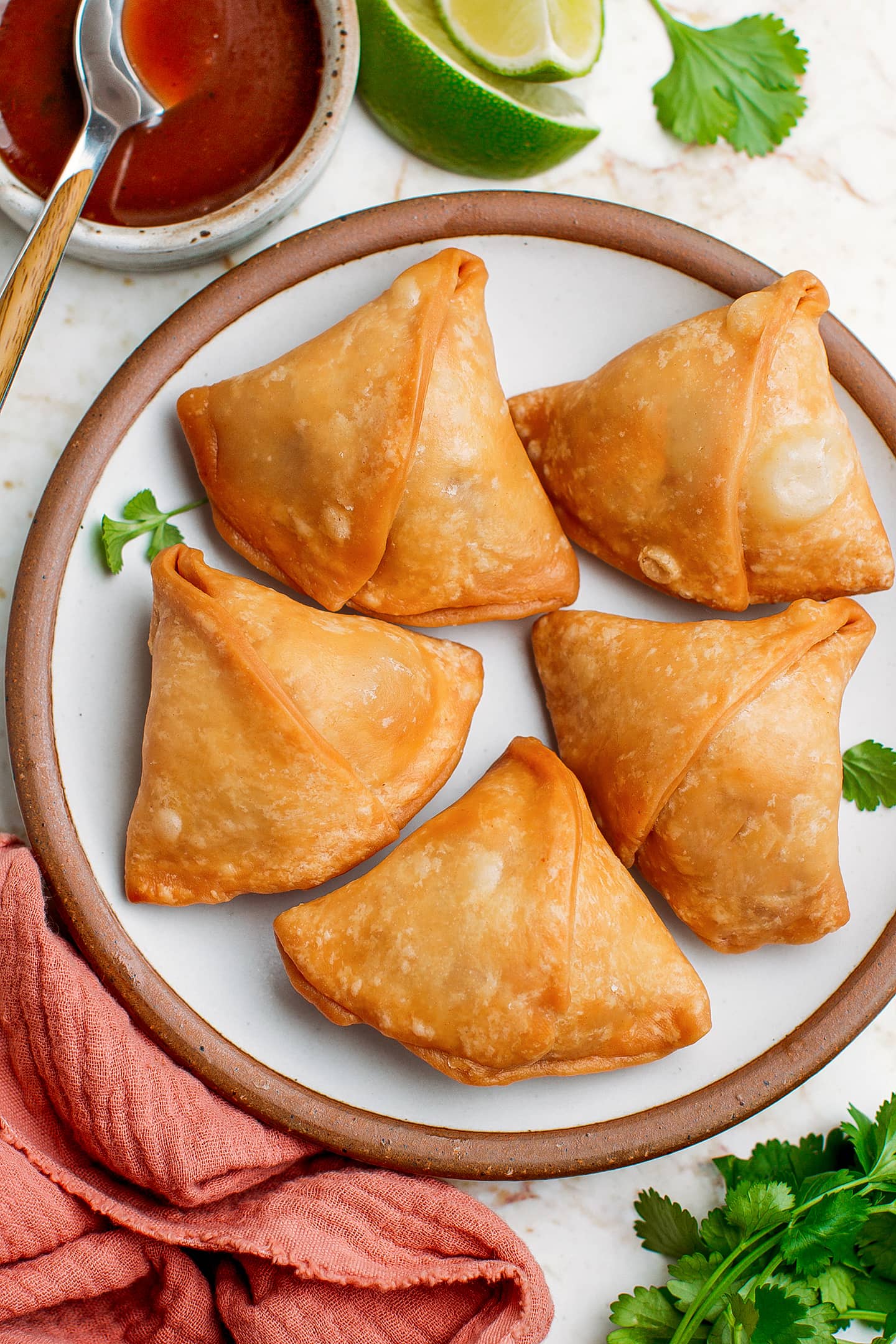
⭐️ Why You Should Try It
- Made from scratch. This vegan samosa recipe is made entirely from scratch! It starts with the wrappers, followed by the potato filling. Then, all you need to do is fill each wrapper and fry them until they turn golden brown. Don’t worry, you will find plenty of step-by-step photos to help you in the process.
- Flavorful and well-seasoned. These samosas are as delicious as the ones from your favorite restaurant without the high price tag! The filling is tender and infused with aromatic spices, while the crust is flaky and crispy.
- Minimal ingredients are required. You won’t need any hard-to-find ingredients. Potatoes, spices, flour, and a few aromatics like ginger, garlic, and shallots are all you need!
📘 What Are Samosas
Samosas are a popular snack that originated in India in the XIII century. While the filling and shape can vary from region to region, it is typically made with potatoes and spices and enclosed in a crispy pastry shell. It is then deep-fried until golden brown and served with a dipping sauce or chutney.
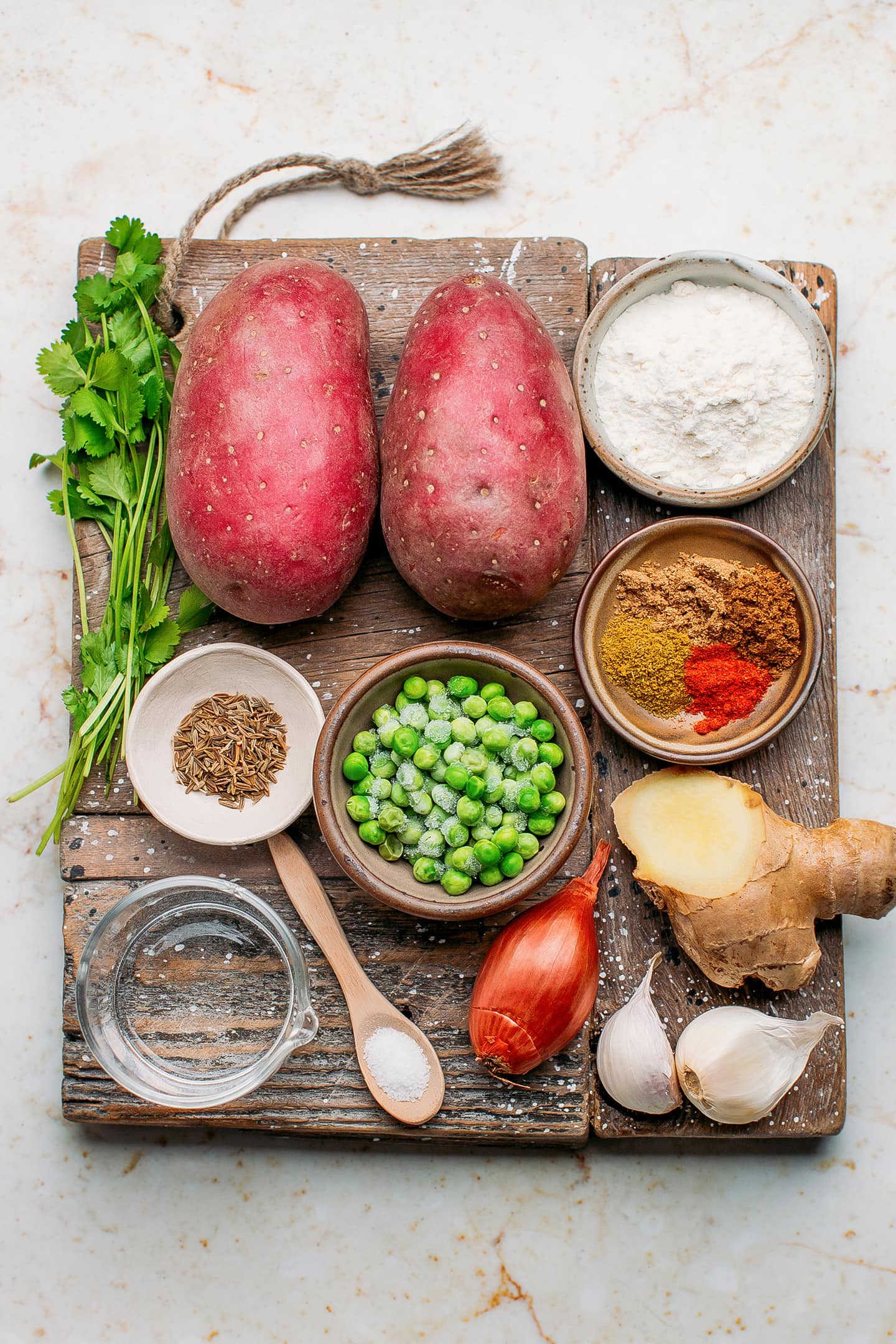
🥔 Ingredient Notes
Here are the ingredients that you will need for the samosa filling:
- Potatoes – Russet or red potatoes work well but any type of white potato will work.
- Shallots – You can use two shallots or half of an onion.
- Garlic
- Ginger – Use fresh ginger for optimal flavor. Your ginger should have a smooth skin with little to no wrinkles.
- Green peas – You can use boiled or frozen green peas. If you don’t have peas, simply omit them or replace them with chopped green beans.
- Cilantro – Chopped fresh cilantro adds freshness and a subtle citrusy flavor.
- Spices – Cumin, coriander, garam masala, and chili.
Then, for the wrappers, you will need:
- Flour – All-purpose flour works best here. Please note that I haven’t tried this recipe with gluten-free flour, so I cannot say if it works.
- Oil – Use a neutral oil such as canola or grapeseed. Note: I use less oil than most samosa wrapper recipes, as I prefer a crunchier dough. Using more oil will result in a more sandy texture.
- Cumin seeds – Optional. If you don’t have cumin seeds, you can simply omit them or replace them with carom seeds.
- Water
- Salt – To season.
- Cornstarch – We will use cornstarch to make a slurry and close the wrappers safely.
🥣 How to Make It
1. Cook the potatoes
The first step consists of cooking the potatoes. To do so, you have two options: you can either boil or steam them. I do not recommend baking them as it tends to dry them, and it won’t work too well in this recipe.
To boil:
- Add the potatoes to a saucepan and cover with water.
- Bring to a boil and let simmer for 25-35 minutes or until fork-tender. Be aware that cooking time will depend on the variety and size of your potatoes.
To steam:
- Place the potatoes in a steamer. You can use a regular steamer or a bamboo basket placed on top of a pot filled with water.
- Steam for about 25 minutes or until the potatoes are fork-tender.
- Let them cool. Let the potatoes cool down for 30-45 minutes. In the meantime, you can prepare the dough for the wrappers.
- Peel and dice the potatoes. Once the potatoes are cool to the touch, peel them and dice them into 1/2-inch cubes. Set aside.
2. Make the dough
- Add everything to a bowl. Add the flour, water, oil, salt, and cumin seeds to a mixing bowl.
- Knead until it forms a dough. Using your hands, knead the dough for about 3 minutes or until it is smooth and uniform. The dough should not be sticky or dry. If the dough is too dry, add an extra teaspoon of water and knead again.
- Let it rest. Wrap the dough in plastic wrap and let it rest for about 2 hours.
3. Sauté the filling
- Sauté the aromatics. Heat the oil in a non-stick skillet over medium heat. Once hot, add the shallots, garlic, and ginger, and sauté for about 3 minutes.
- Add the potatoes. Add the diced potatoes, green peas, spices, and salt, and sauté for another 3-5 minutes. Remove from heat and set aside.
4. Wrap the samosas
- Divide the dough. After the resting time, divide the dough into 6 equal balls.
- Flatten a ball. Flatten a ball of dough into a disc of about 1/8-inch (3mm) thickness using a rolling pin.
- Halve the dough. Slice the disc in half to create two half-moon shapes.
- Prepare the slurry. In a small bowl, dissolve the cornstarch with the water. Dip your finger in the slurry and brush the edges of the dough.
- Make a “cone”. Fold the half-moon disc into a cone by joining the straight edges together. Press well to seal.
- Fill it. Fill the cone with about one tablespoon of the potato filling and pack it tightly. Do not overfill it, and leave about 1/2 inch (1cm) to seal the samosa.
- Close the samosa. Finally, pinch the edges together to enclose the filling in the wrapper. Transfer the samosa to a plate or baking sheet lined with parchment paper and repeat with the remaining dough and filling.
5. Deep-fry
- Heat the oil. To prevent many bubbles from forming on the crust, you must start frying at a lower temperature and slowly increase it. Start by heating the oil at a temperature of about 194°F (90°C). Next, add the samosa (I usually fry 4-5 at a time).
- Fry the samosas. Fry the samosa at this temperature for 3-4 minutes. Next, turn up the heat until it reaches 356°F (180°C) and fry for another 7-10 minutes or until the samosas are golden brown. Be aware those temperatures do not have to be perfectly exact. Transfer the fried samosas to a plate lined with kitchen paper towels to remove the excess oil.
- Repeat. To fry the remaining samosas, turn off the heat and wait until the oil goes down to 194°F (90°C). Repeat the process.
How to Air-Fry Samosas
If you prefer healthier samosas, you can air-fry them! They taste about 80% as good as the deep-fried ones. To air-fry samosas: Preheat your air fryer to 400°F (200°C). Slightly brush the samosas with oil and air fry them for 15 minutes, flipping them once halfway through air-frying.
📔 Tips
- Prepare ahead of time. While making samosas is easy, it does require quite some time. I highly recommend preparing the filling or at least cooking the potatoes the day before. This way, you just have to make the dough, fill the samosas, and deep-fry the next day.
- Check the temperature of the oil. For a smooth shell, frying at a lower temperature for a longer time works best. If the oil is too hot when adding the samosas, many bubbles will form on their surface. It doesn’t make them any less tasty but less presentable, to say the least.
- Do not overfill the samosas. To ensure the samosas don’t open while frying, make sure not to overfill them. Leave about 1/2 inch (1cm) to have enough dough to seal them properly.
- Ensure they are completely sealed. If your samosas are not sealed properly, they will open during frying and the filling may burn. Do not forget to brush the edges with the cornstarch slurry and tightly press the edges together.
🫛 Variations
The filling of these samosas is versatile, so feel free to include what you have on hand. Here are a few ideas:
- Chickpeas: Add 1/4 cup of cooked chickpeas for extra protein and texture. Other cooked beans or legumes work as well. You can add green or red lentils or white navy beans.
- Cauliflower: Replace half the potatoes with finely chopped steamed cauliflower for a lighter option.
- Green beans: Boil or steam green beans and slice them into 1/2-inch pieces. Alternatively, you can use canned cooked green beans to save time.
- Nuts: Add roughly chopped nuts such as roasted cashews, peanuts, or almonds.
- Dried fruits: Raisins or chopped dates add a natural sweetness to the filling.
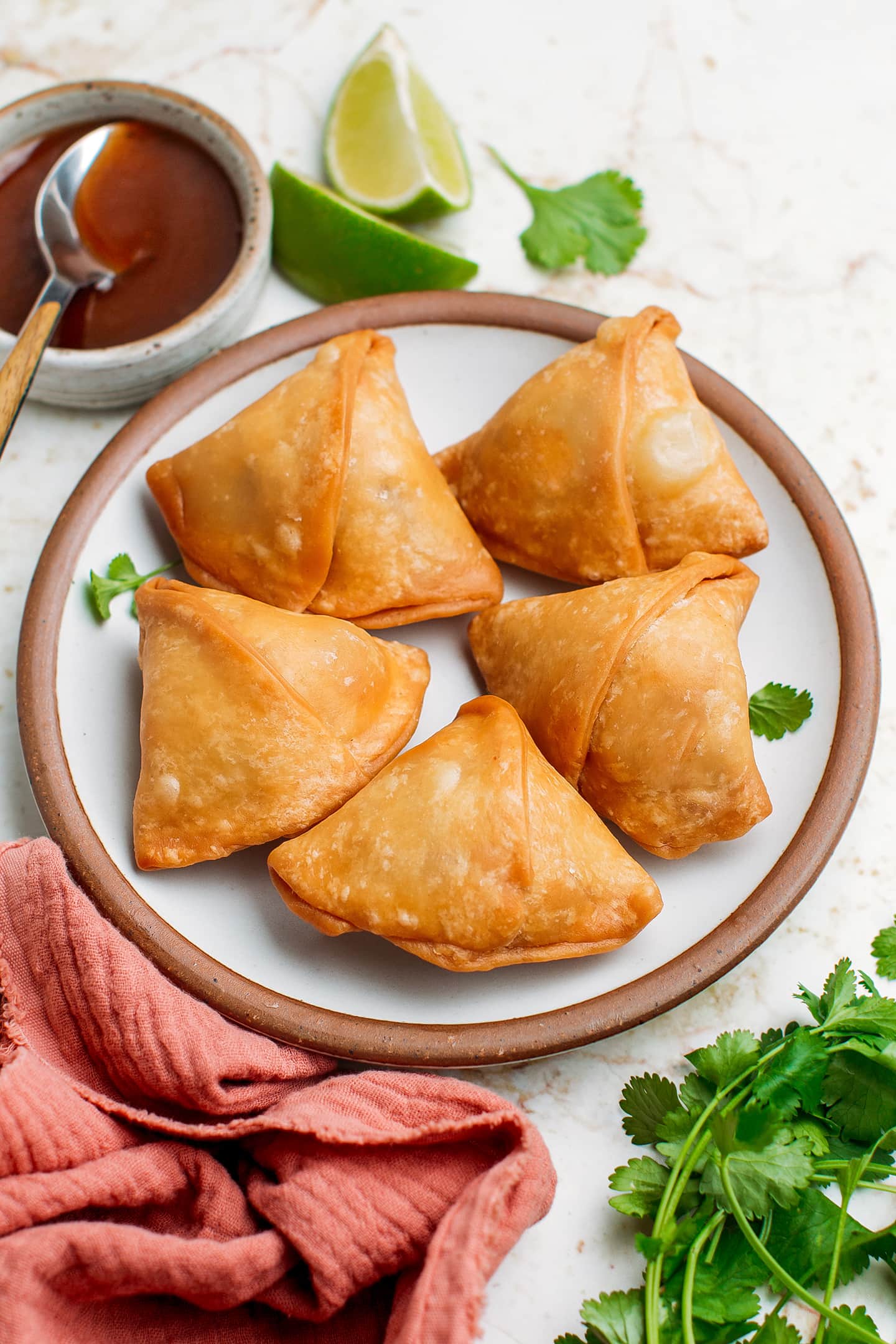
🥫 What to Serve It With
You can serve these vegan samosas with tamarind dipping sauce (our favorite!), sweet and sour dipping sauce, or mint sauce!
❄️ Storing and Reheating
- To store: You can store fried samosas in the refrigerator for up to 4 days.
- To freeze: You can freeze unfried samosas by wrapping each one in plastic wrap. Then, place them in a freezer bag and freeze for up to 2 months. Thaw overnight in the refrigerator before deep-frying.
- To reheat: To reheat fried samosas, place them on a baking sheet and warm them in the oven at 350°F (175°C) for 8-10 minutes. You can also reheat them in a 350°F (175°C) preheated air fryer for 7-8 minutes.
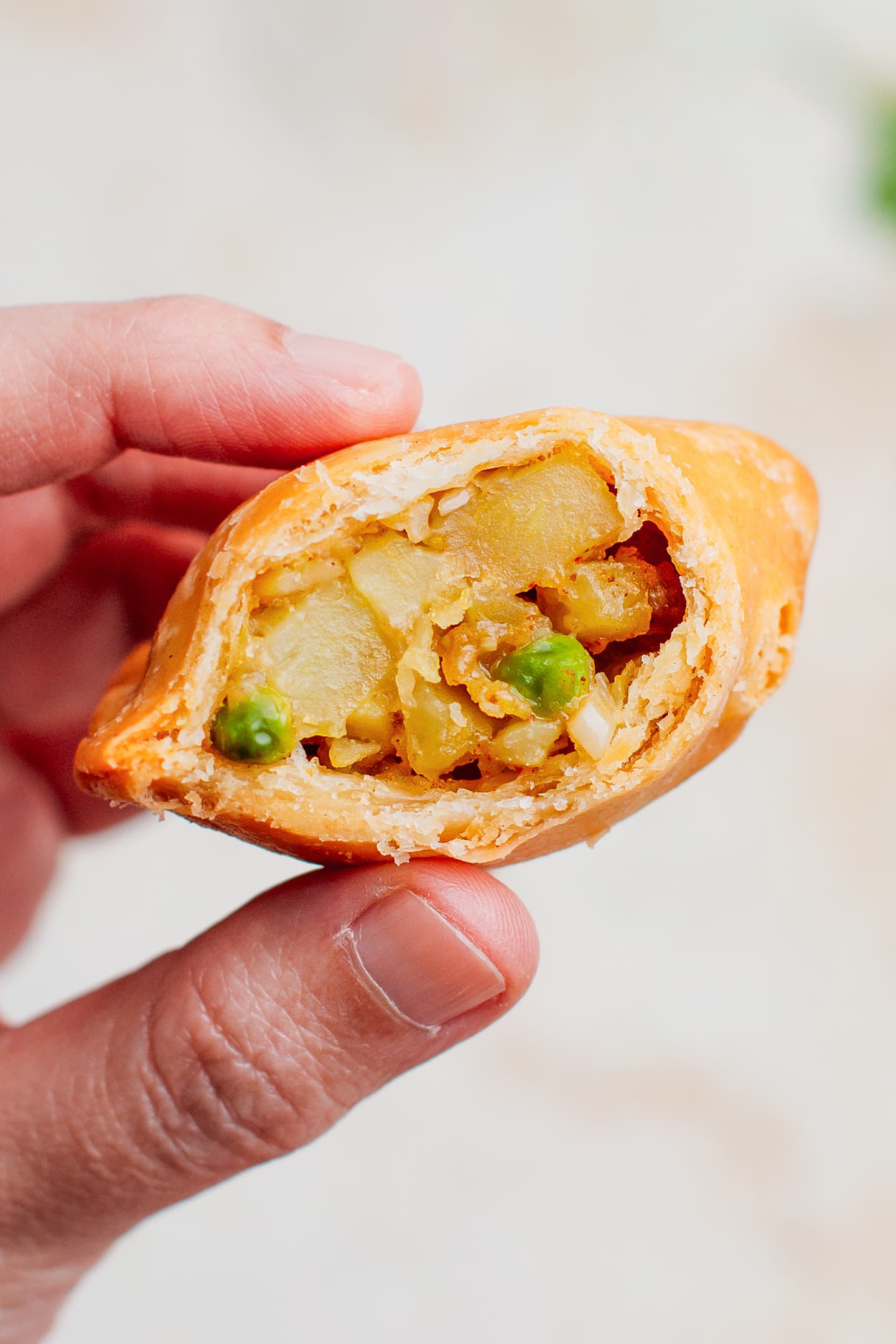
💬 FAQ
The oil was too hot when you added the samosas. You should start frying at a low temperature and slowly increase the heat.
The edges were not sealed properly. Press them very tightly between your fingers to seal the samosas completely.
I hope you will love these homemade vegan samosas! They are super crispy on the outside, tender on the inside, and so flavorful! Although it’s fried, samosas are still a delicious appetizer that will hurt no one when enjoyed once in a while!
🇮🇳 More Indian-Inspired Recipes
⭐️ Did you like this recipe? Let us know in the comments below, and tag us on Facebook, Instagram, or Pinterest!
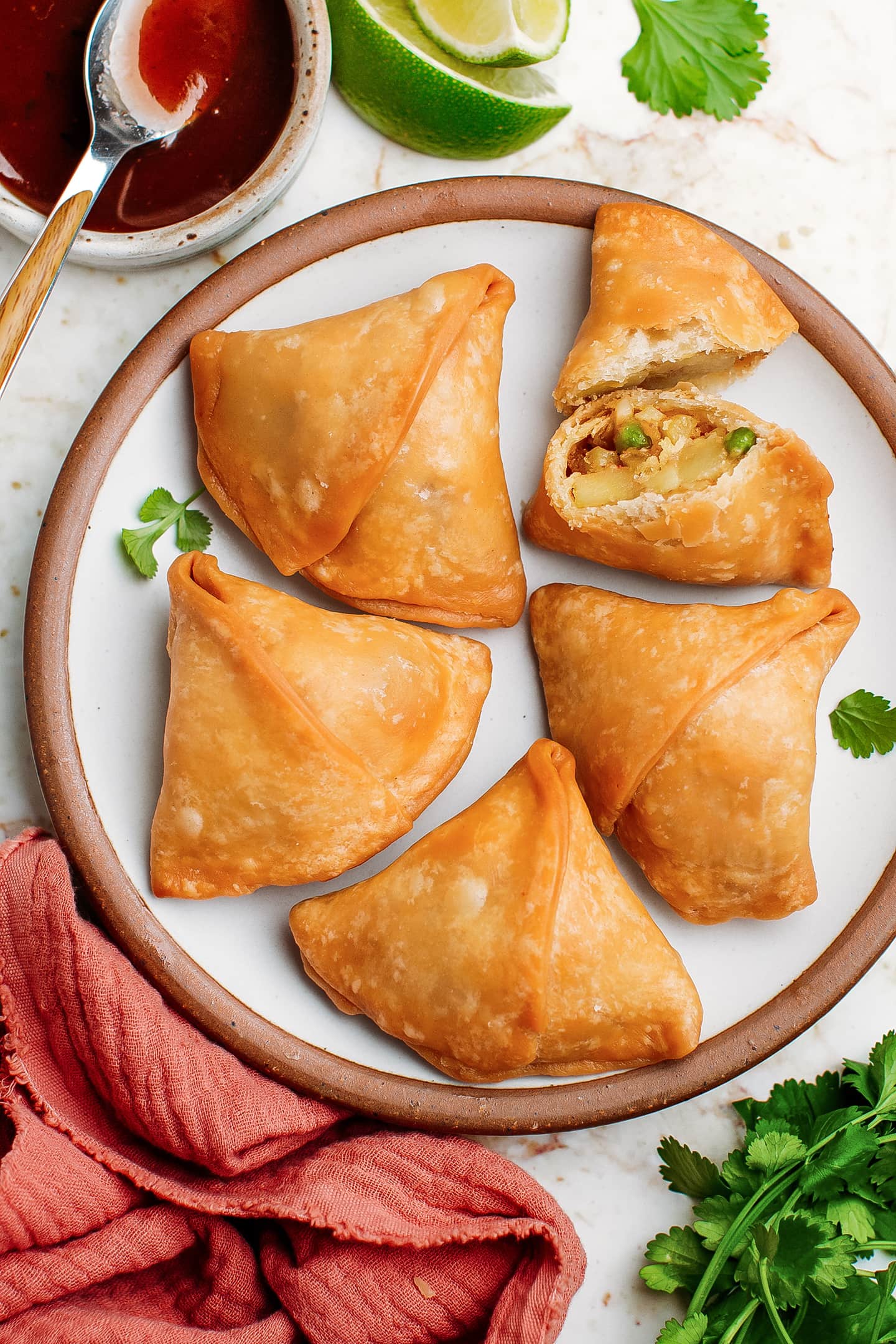

Want to Save This Recipe?
Enter your email below & we’ll send it straight to your inbox! Plus, you will receive new recipes every week!
I’d like to receive more tips & recipes from Full of Plants.
This site is protected by reCAPTCHA and the Google Privacy Policy and Terms of Service apply.
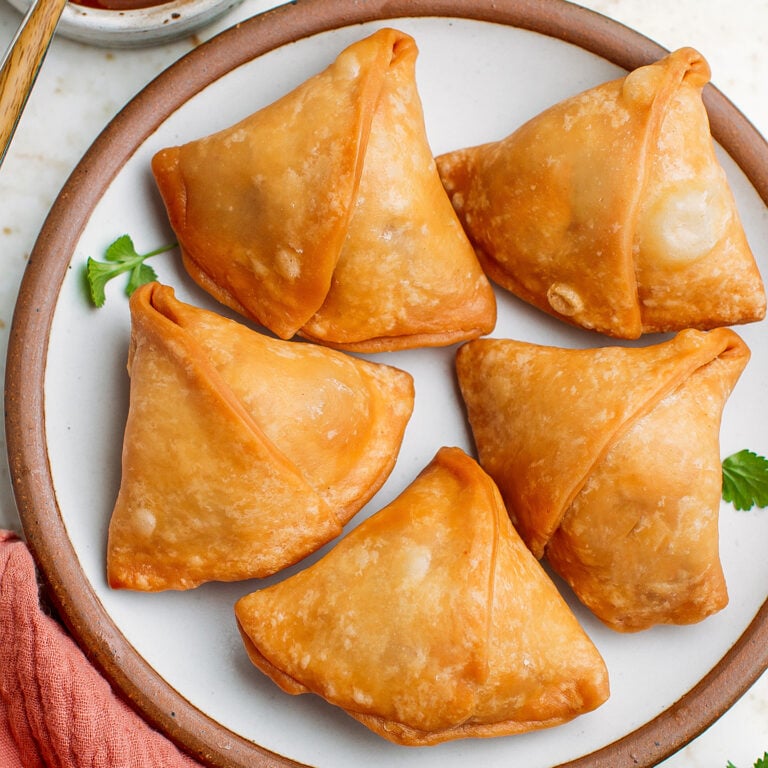
Vegan Samosas
Ingredients
Wrappers
- 1 and 1/4 cup all-purpose flour
- 5-6 tbsp water
- 1 tbsp oil
- 1/8 tsp salt
- 1/4 tsp cumin seeds
Filling
- 2 medium white potatoes about 13 ounces
- 2 tbsp oil
- 2 cloves of garlic minced
- 2 shallots minced
- 2 tsp minced ginger
- 3 tbsp green peas
- 1/2 tsp ground cumin
- 1/2 tsp ground coriander
- 1/4 tsp chili powder
- 1/4 tsp garam masala
- 1/2 tsp salt
- 3 tbsp chopped cilantro
- 3 cups neutral oil for frying
Slurry
- 1 tbsp cornstarch
- 1 tbsp water
Instructions
Cook the potatoes
- Boil the potatoes. Add the potatoes to a saucepan and cover with water. Bring to a boil and let simmer for 25-35 minutes or until fork-tender. Be aware that cooking time will depend on the variety and size of your potatoes.
- Let them cool. Let the potatoes cool down for 30-45 minutes. In the meantime, prepare the dough for the wrappers.
Make the dough
- Add everything to a bowl. Add the flour, water, oil, salt, and cumin seeds to a mixing bowl.
- Knead until it forms a dough. Using your hands, knead the dough for about 3 minutes or until it is smooth and uniform. The dough should not be sticky or dry. If the dough is too dry, add an extra teaspoon of water and knead again.
- Let it rest. Wrap the dough in plastic wrap and let it rest for about 2 hours.
Make the filling
- Peel and dice the potatoes. Once the potatoes are cool to the touch, peel them and dice them into 1/2-inch cubes.
- Sauté the aromatics. Heat the oil in a non-stick skillet over medium heat. Once hot, add the shallots, garlic, and ginger, and sauté for about 3 minutes.
- Add the potatoes. Add the diced potatoes, green peas, spices, and salt, and sauté for another 3-5 minutes. Stir to coat the potatoes with the spices and aromatics. Remove from heat and set aside.
Wrap the samosas
- Divide the dough. After the resting time, divide the dough into 6 equal balls. Flatten a ball of dough into a disc of about 1/8-inch (3mm) thickness using a rolling pin.
- Halve the dough. Slice the disc in half to create two half-moon shapes.
- Prepare the slurry. In a small bowl, dissolve the cornstarch with the water. Dip your finger in the slurry and brush the edges of the dough.
- Make a “cone”. Fold the half-moon disc into a cone by joining the straight edges together. Press well to seal.
- Fill it. Fill the cone with about one tablespoon of the potato filling and pack it tightly. Do not overfill it, and leave about 1/2 inch (1cm) to seal the samosa.
- Close the samosa. Finally, pinch the edges together to enclose the filling in the wrapper. Transfer the samosa to a plate or baking sheet lined with parchment paper and repeat with the remaining dough and filling.
Deep-fry
- Heat the oil. To prevent many bubbles from forming on the crust, you must start frying at a lower temperature and slowly increase it. Start by heating the oil at a temperature of about 194°F (90°C). Next, add the samosa (I usually fry 4-5 at a time).
- Fry the samosas. Fry the samosa at this temperature for 3-4 minutes. Next, turn up the heat until it reaches 356°F (180°C) and fry for another 7-10 minutes or until the samosas are golden brown. Be aware those temperatures do not have to be perfectly exact. Transfer the fried samosas to a plate lined with kitchen paper towels to remove the excess oil.
- Repeat. To fry the remaining samosas, turn off the heat and wait until the oil goes down to 194°F (90°C). Repeat the process.
- You can store fried samosas in the refrigerator for up to 4 days.
Notes
- Prepare ahead of time. While making samosas is easy, it does require quite some time. I highly recommend preparing the filling or at least cooking the potatoes the day before. This way, you just have to make the dough, fill the samosas, and deep-fry the next day.
- Check the temperature of the oil. For a smooth shell, frying at a lower temperature for a longer time works best. If the oil is too hot when adding the samosas, many bubbles will form on their surface. It doesn’t make them any less tasty but less presentable, to say the least.
- Do not overfill the samosas. To ensure the samosas don’t open while frying, make sure not to overfill them. Leave about 1/2 inch (1cm) to have enough dough to seal them properly.
- Ensure they are completely sealed. If your samosas are not sealed properly, they will open during frying and the filling may burn. Do not forget to brush the edges with the cornstarch slurry and tightly press the edges together.
Nutrition

About the Author
Thomas Pagot is the founder, photographer, and recipe developer behind Full of Plants. He created the blog in 2016 as a personal cookbook for vegan recipes. Through years of recipe development, Thomas has successfully grown Full of Plants into a trusted resource for plant-based recipes.

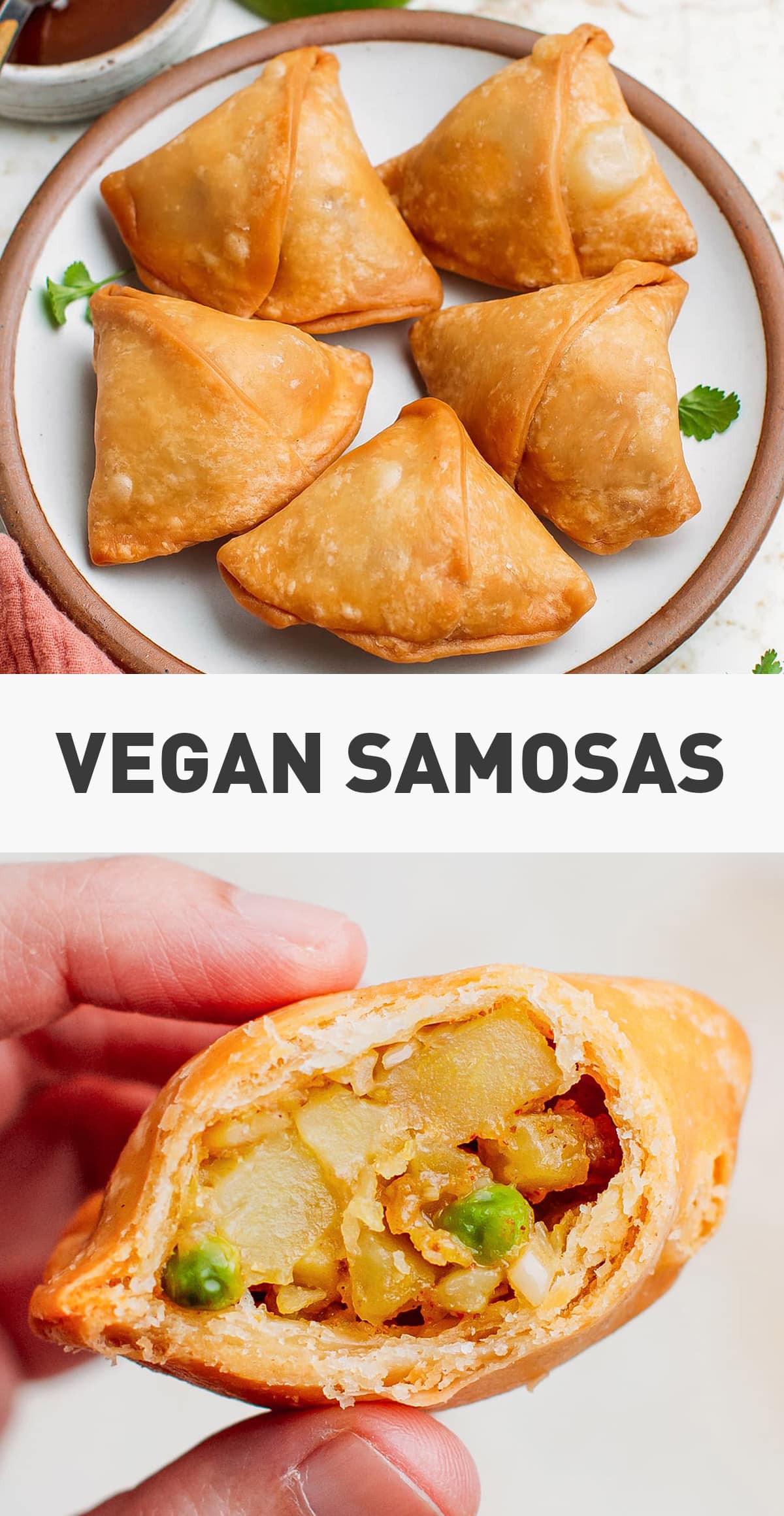
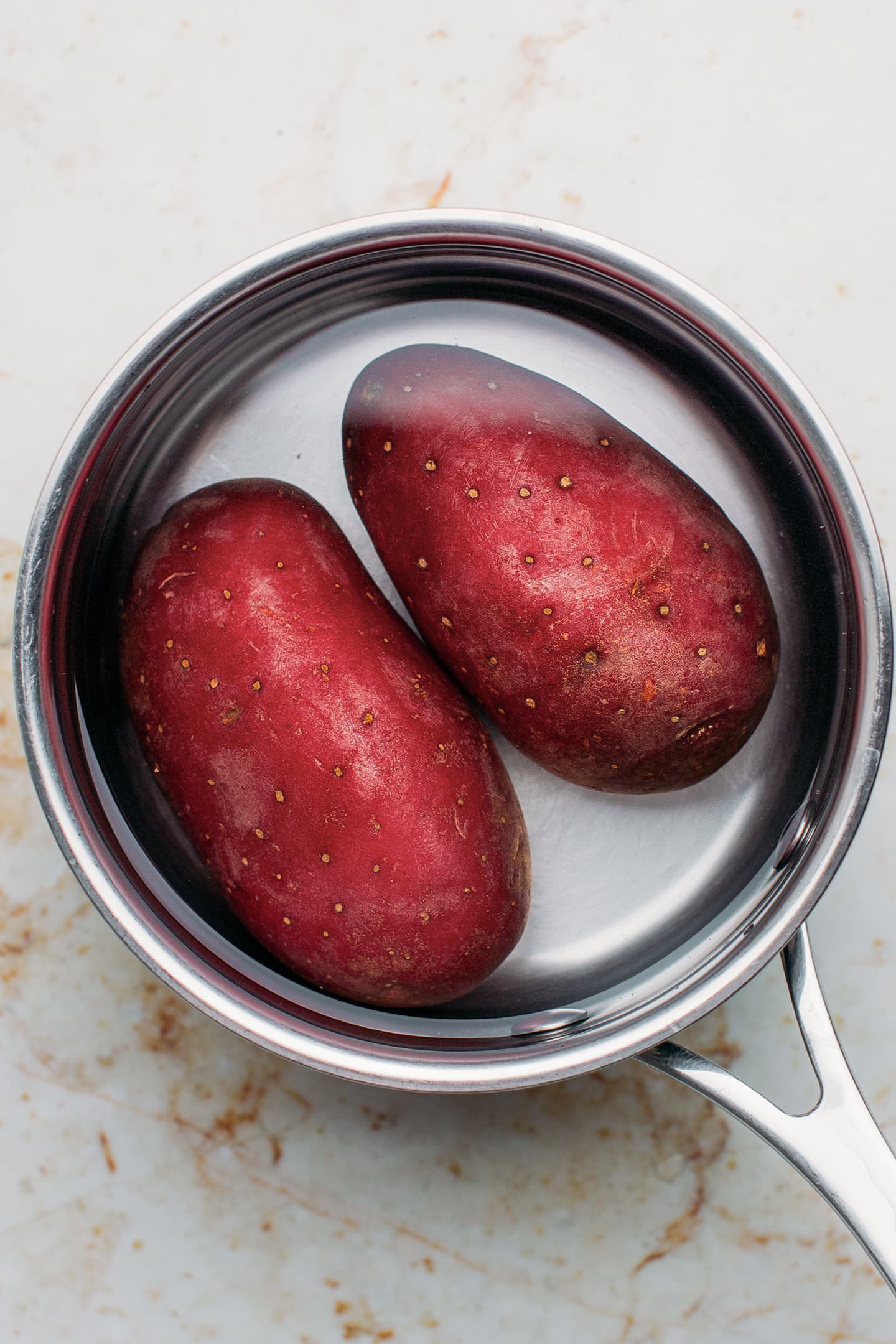
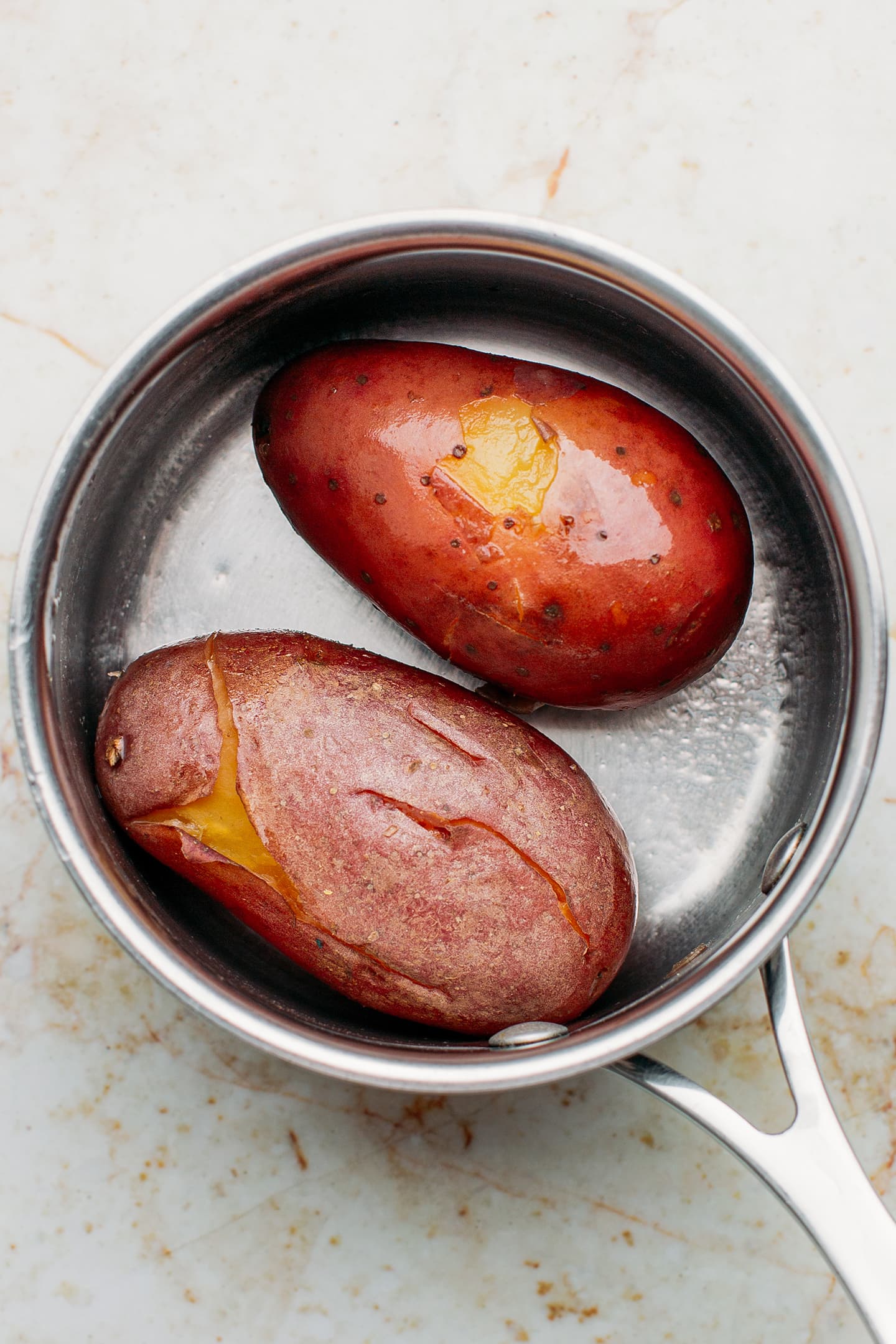
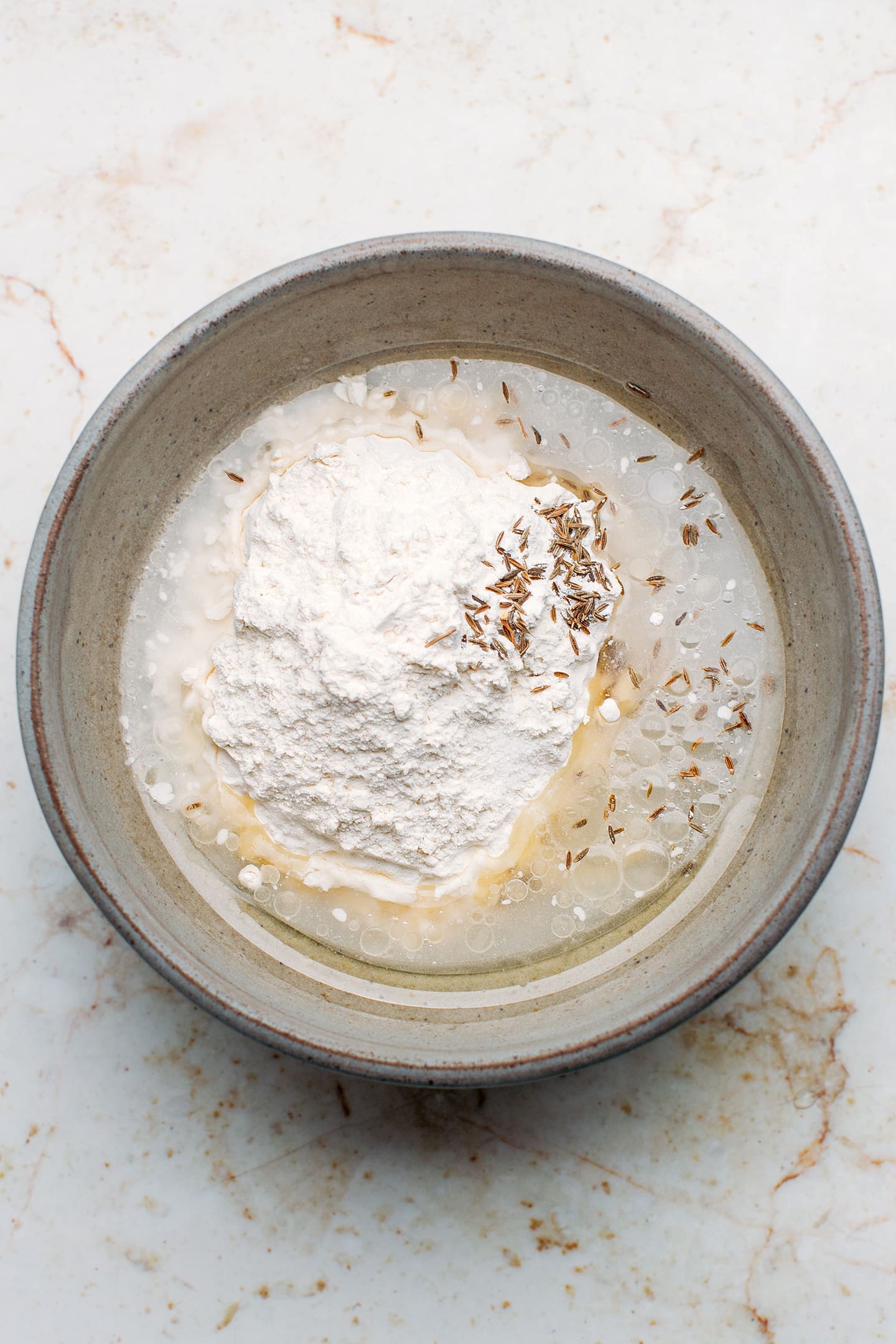
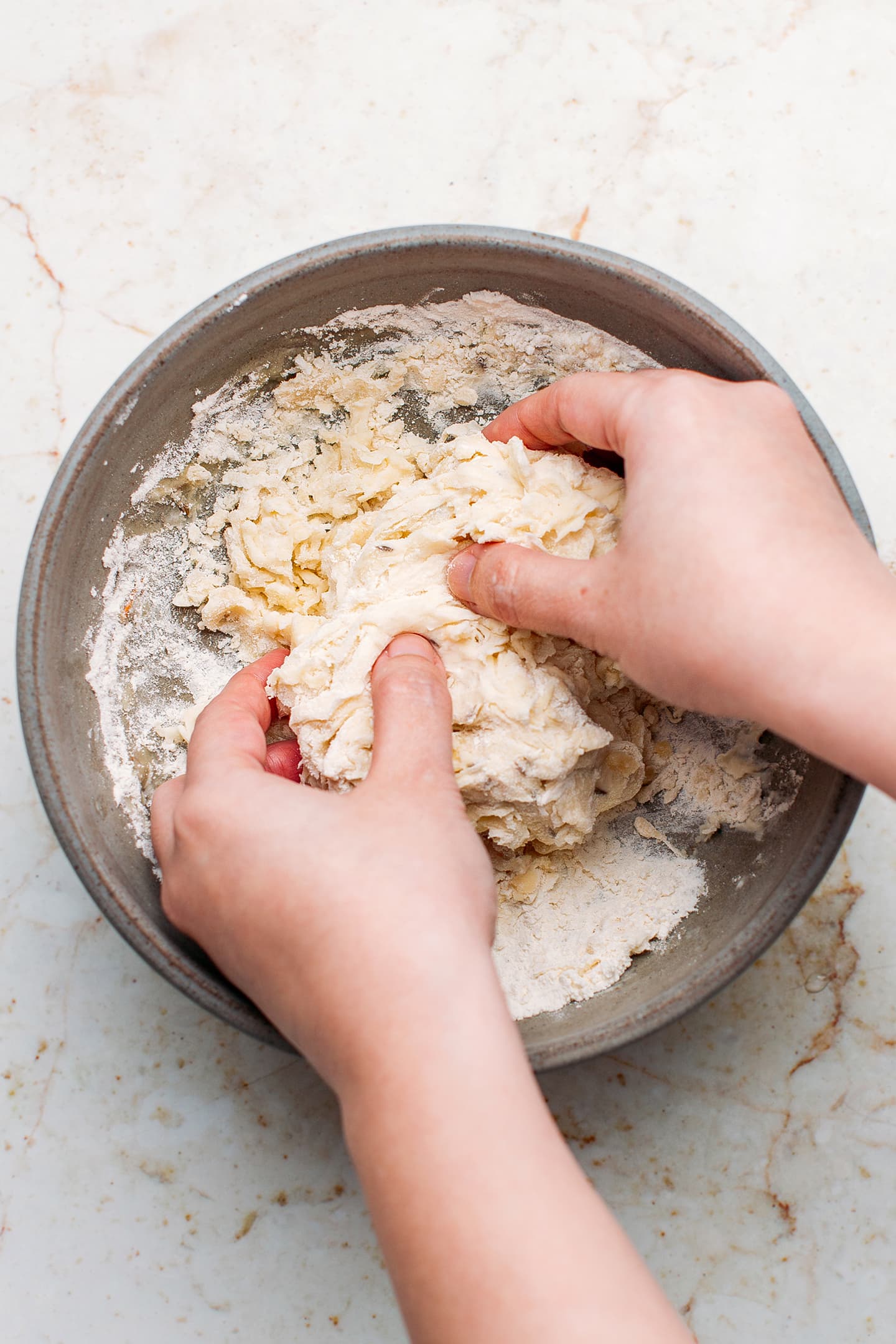





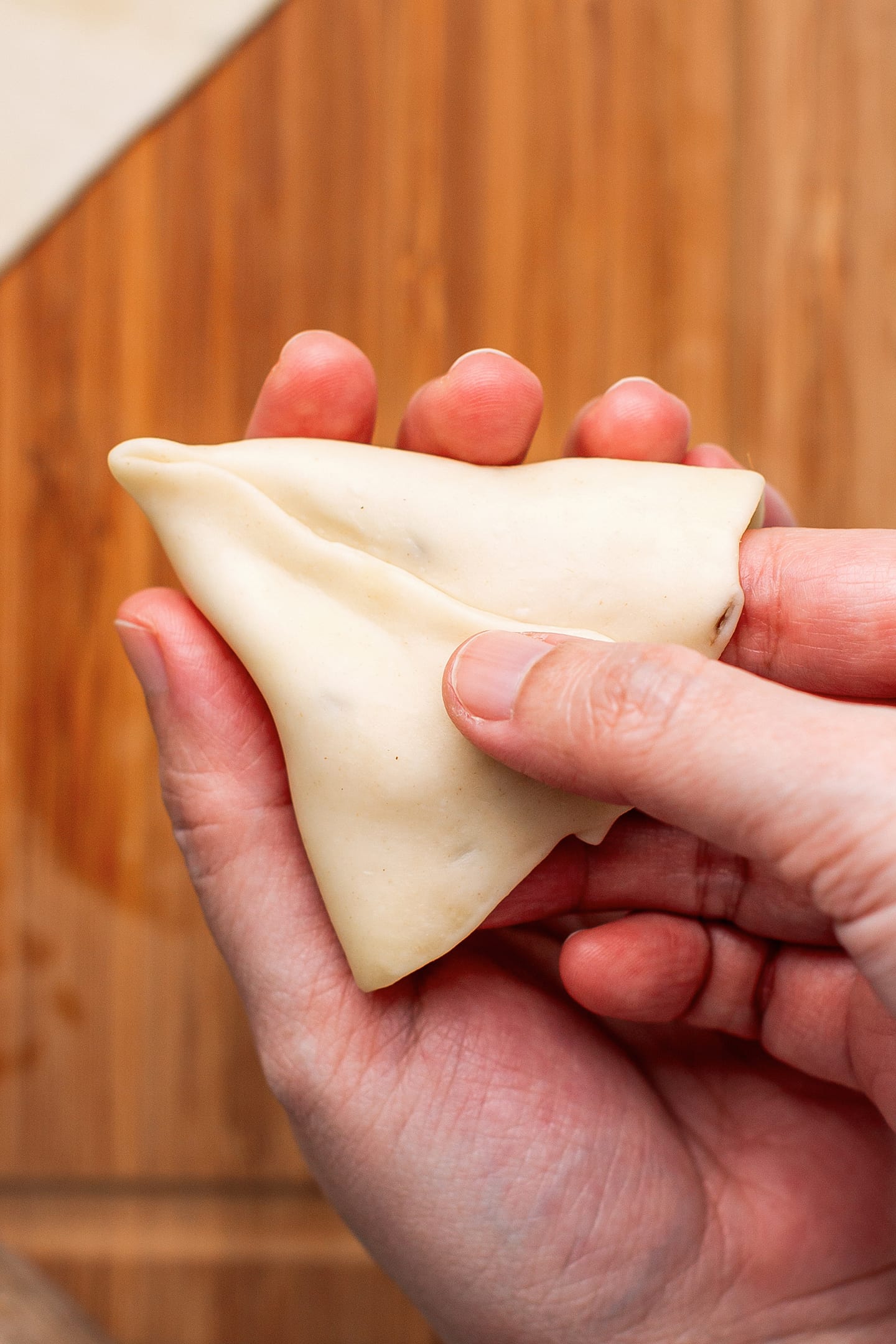

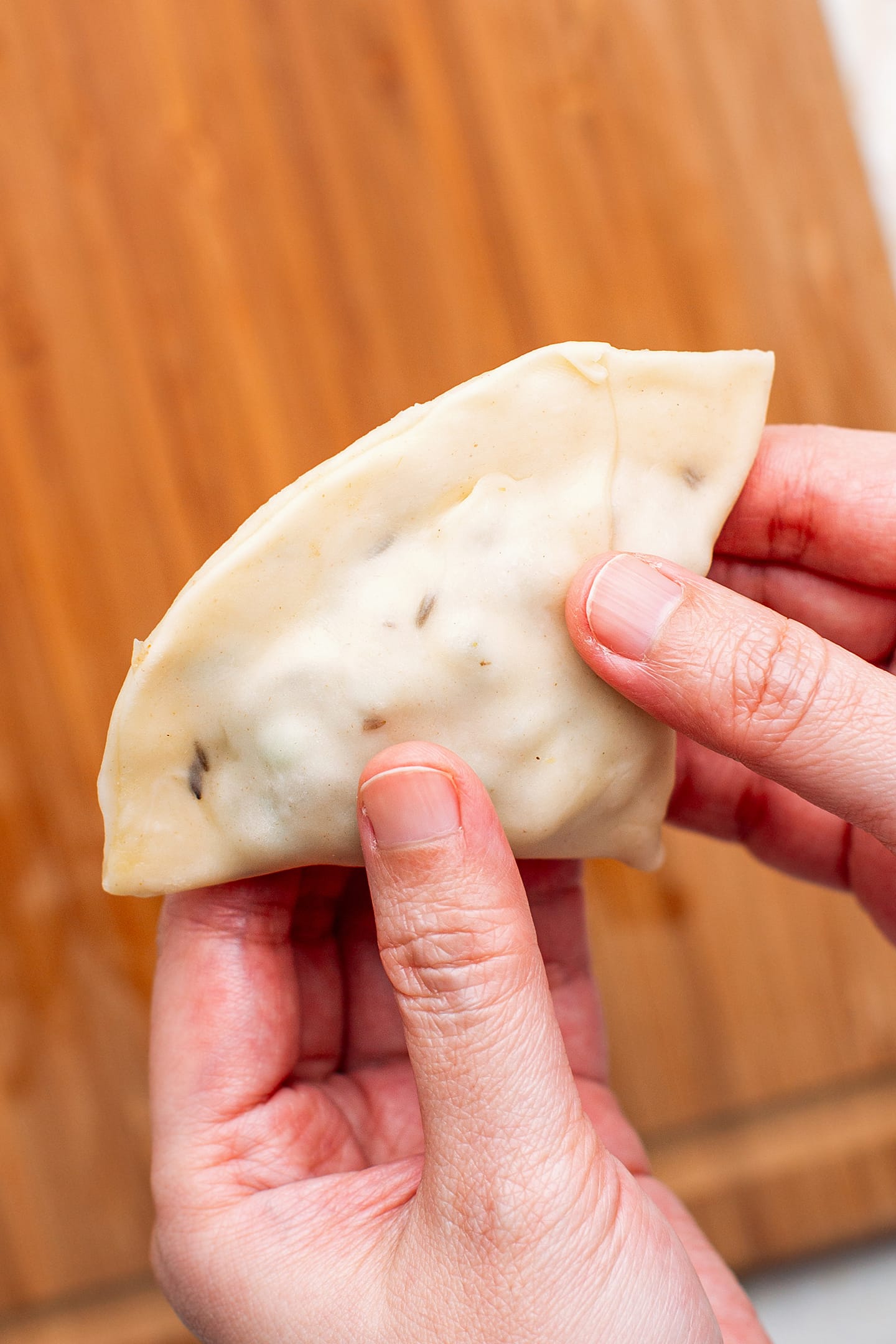

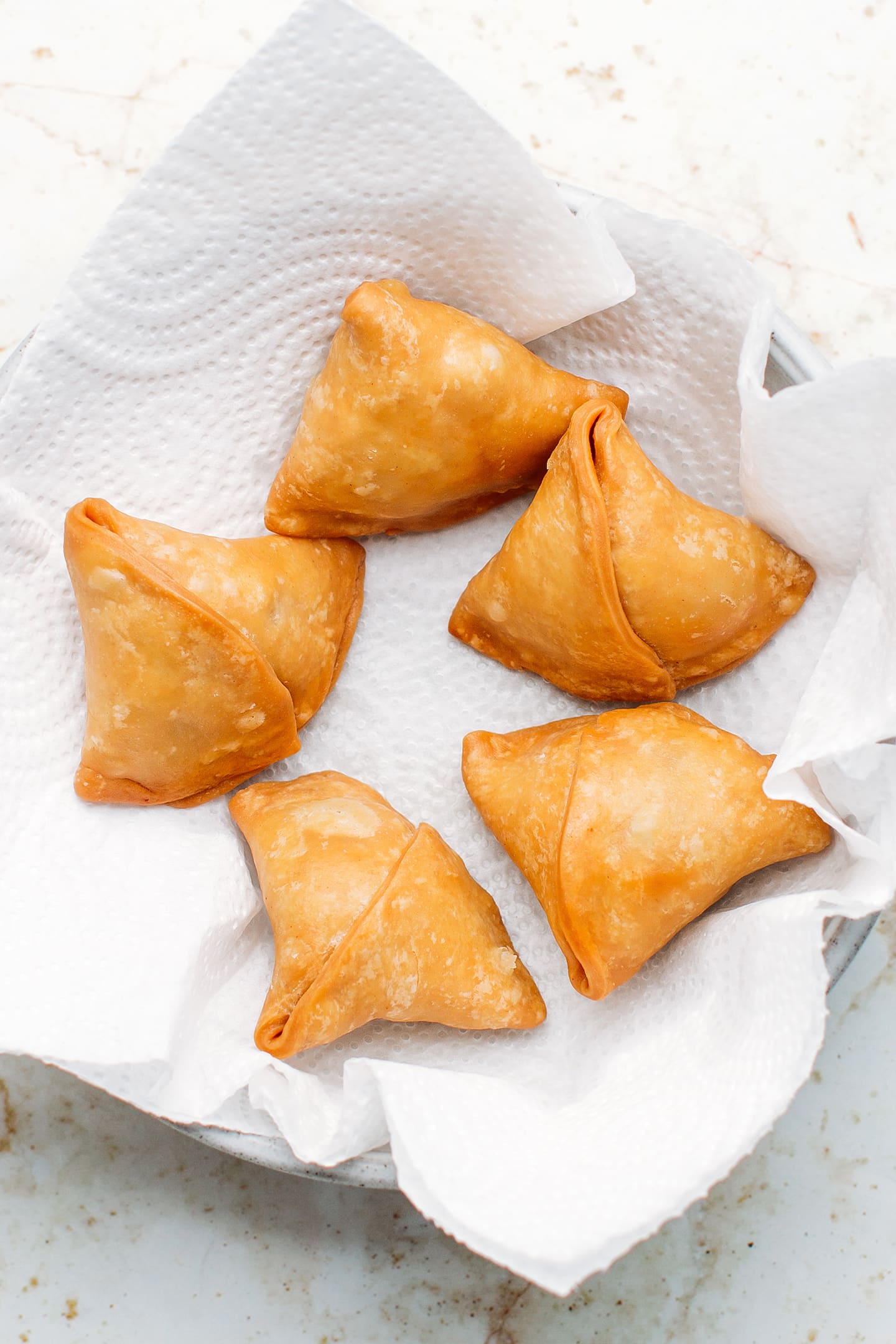

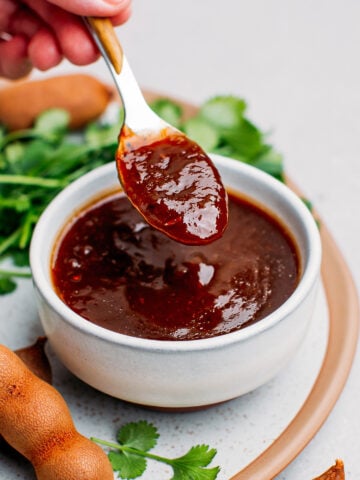



Leave a Comment
Amazing recipe. Just tried it. My family loved it. Thank you.
Thanks Emy!
What about baking them? I’ve read that they can be baked too. If OK at what temp and for how long?
Thanks
Joe
God bless
Hi Joe,
You can brush them with oil and bake them for 15-18 minutes at 400°F.